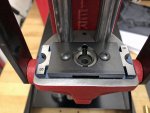I have been reloading 308 Win and 6.5mm Creedmoor and now started reloading 223 Rem. I have never loaded 223 Rem before and have encountered inconsistent full length resizing when I was setting up and adjusting the full length resizing die.
EQUIPMENT
While adjusting the Redding FL die I found I had to cam-over a small amount to achieve 0 on my RCBS Precision Mic. When I checked more cases I found I was getting readings from -1 to +2.5. That’s a variance of 0.0035”.
I have a brand new set of Dillon carbide 223 Rem dies I purchased years ago and have never used. I decided to install these in the Co-Ax press to compare results with the Redding FL resizing die. Being carbide the Dillon dies are designed to not contact the shell holder and be able to full length resize a fired case. The results were:
Redding FL Die (20 cases resized): Maximum 0.005” variance. Most were from +1 to -1, which is 0.002” variance.
Dillon Carbide FL Die (20 cases resized): Maximum 0.0005” variance. That's 1/10 of the Redding FL Die variance. Very impressive.
I am thinking cam-over of the Forester press is creating the inconsistent resizing results and the fix would be to return the FL resizing die to Redding to remove 0.005” from the base of the die so I don’t need to Cam-over. Has anyone else experienced inconsistent full length resizing with cam-over?
EQUIPMENT
- Forester Co-Ax Press
- Redding Type S Bushing Style Full Length Die
- Once Fired Winchester 223 Rem Cases (Note: Fired from my rifles)
While adjusting the Redding FL die I found I had to cam-over a small amount to achieve 0 on my RCBS Precision Mic. When I checked more cases I found I was getting readings from -1 to +2.5. That’s a variance of 0.0035”.
I have a brand new set of Dillon carbide 223 Rem dies I purchased years ago and have never used. I decided to install these in the Co-Ax press to compare results with the Redding FL resizing die. Being carbide the Dillon dies are designed to not contact the shell holder and be able to full length resize a fired case. The results were:
Redding FL Die (20 cases resized): Maximum 0.005” variance. Most were from +1 to -1, which is 0.002” variance.
Dillon Carbide FL Die (20 cases resized): Maximum 0.0005” variance. That's 1/10 of the Redding FL Die variance. Very impressive.
I am thinking cam-over of the Forester press is creating the inconsistent resizing results and the fix would be to return the FL resizing die to Redding to remove 0.005” from the base of the die so I don’t need to Cam-over. Has anyone else experienced inconsistent full length resizing with cam-over?


